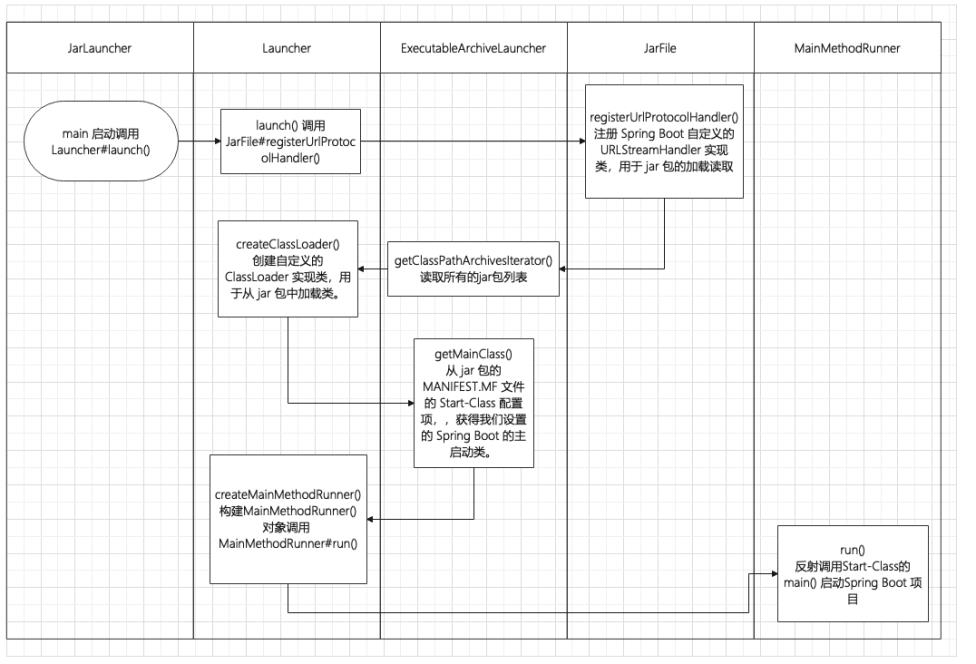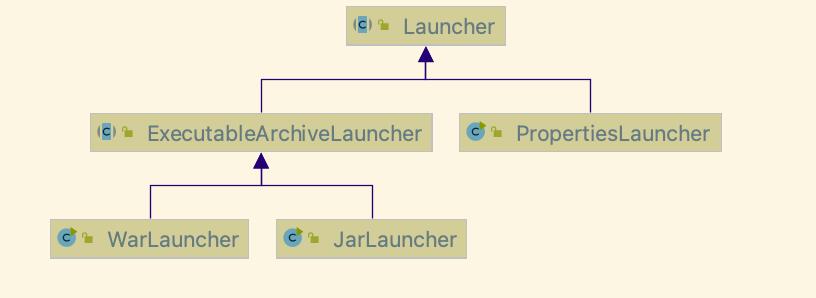我说 Spring Boot 不能用 jar 包启动?leader 过来就是一 jo。。。
Posted 微笑很纯洁
tags:
篇首语:本文由小常识网(cha138.com)小编为大家整理,主要介绍了我说 Spring Boot 不能用 jar 包启动?leader 过来就是一 jo。。。相关的知识,希望对你有一定的参考价值。
哈喽,大家好,我是指北君。
可能很多初学者会比较困惑,Spring Boot 是如何做到将应用代码和所有的依赖打包成一个独立的 Jar 包,因为传统的 Java 项目打包成 Jar 包之后,需要通过 -classpath 属性来指定依赖,才能够运行。我们今天就来分析讲解一下 Spring Boot 的启动原理。
1. Spring Boot 打包插件
Spring Boot 提供了一个名叫 spring-boot-maven-plugin 的 maven 项目打包插件,可以方便的将 Spring Boot 项目打成 jar 包。这样我们就不再需要部署 Tomcat 、Jetty等之类的 Web 服务器容器啦。
我们先看一下 Spring Boot 打包后的结构是什么样的,打开 target 目录我们发现有两个jar包:
hello-0.0.1-SNAPSHOT.jar:17.3MB
hello-0.0.1-SNAPSHOT.jar.original:3KB
其中,hello-0.0.1-SNAPSHOT.jar 是通过 Spring Boot 提供的打包插件采用新的格式打成 Fat Jar,包含了所有的依赖;而 hello-0.0.1-SNAPSHOT.jar.original 则是Java原生的打包方式生成的,仅仅只包含了项目本身的内容。
2. SpringBoot FatJar 的组织结构
我们将 Spring Boot 打的可执行 Jar 展开后的结构如下所示:
.
├── BOOT-INF
│ ├── classes
│ │ ├── application.properties
│ │ └── com
│ │ └── javanorth
│ │ └── hello
│ │ └── HelloApplication.class
│ └── lib
│ ├── spring-boot-2.5.0.RELEASE.jar
│ ├── spring-boot-autoconfigure-2.5.0.RELEASE.jar
│ ├── spring-boot-configuration-processor-2.5.0.RELEASE.jar
│ ├── spring-boot-starter-2.5.0.RELEASE.jar
│ ├── ...
├── META-INF
│ ├── MANIFEST.MF
│ └── maven
│ └── com.javanorth
│ └── hello
│ ├── pom.properties
│ └── pom.xml
│
├── org
│ └── springframework
│ └── boot
│ └── loader
│ ├── ExecutableArchiveLauncher.class
│ ├── JarLauncher.class
│ ├── Launcher.class
│ ├── MainMethodRunner.class
│ ├── ...
BOOT-INF目录:包含了我们的项目代码(classes目录),以及所需要的依赖(lib 目录)
META-INF目录:通过 MANIFEST.MF 文件提供 Jar包的元数据,声明了 jar 的启动类
org.springframework.boot.loader:Spring Boot 的加载器代码,实现的 Jar in Jar 加载的魔法源
我们看到,如果去掉BOOT-INF目录,这将是一个非常普通且标准的Jar包,包括元信息以及可执行的代码部分,其/META-INF/MAINFEST.MF指定了Jar包的启动元信息,org.springframework.boot.loader 执行对应的逻辑操作。
3. MAINFEST.MF 元信息分析
元信息内容如下所示:
Manifest-Version: 1.0
Created-By: Maven Jar Plugin 3.2.0
Build-Jdk-Spec: 11
Implementation-Title: hello
Implementation-Version: 0.0.1-SNAPSHOT
Main-Class: org.springframework.boot.loader.JarLauncher
Start-Class: com.javanorth.hello.HelloApplication
Spring-Boot-Version: 2.5.0
Spring-Boot-Classes: BOOT-INF/classes/
Spring-Boot-Lib: BOOT-INF/lib/
Spring-Boot-Classpath-Index: BOOT-INF/classpath.idx
Spring-Boot-Layers-Index: BOOT-INF/layers.idx
它相当于一个 Properties 配置文件,每一行都是一个配置项目。重点来看看两个配置项:
Main-Class 配置项:Java 规定的 jar 包的启动类,这里设置为 spring-boot-loader 项目的 JarLauncher 类,进行 Spring Boot 应用的启动。
Start-Class 配置项:Spring Boot 规定的主启动类,这里设置为我们定义的 Application 类。
Spring-Boot-Classes 配置项:指定加载应用类的入口
Spring-Boot-Lib 配置项: 指定加载应用依赖的库
4. 启动原理
Spring Boot 的启动原理如下图所示:

5. 源码分析
5.1 org.springframework.boot.loader.JarLauncher
JarLauncher 类是针对 Spring Boot jar 包的启动类, 完整的类图如下所示:

其中的 WarLauncher 类,是针对 Spring Boot war 包的启动类。启动类 org.springframework.boot.loader.JarLauncher 并非为项目中引入类,而是 spring-boot-maven-plugin 插件 repackage 追加进去的。接下来我们先来看一下 JarLauncher 的源码,比较简单,如下图所示:
public class JarLauncher extends ExecutableArchiveLauncher {
private static final String DEFAULT_CLASSPATH_INDEX_LOCATION = "BOOT-INF/classpath.idx";
static final EntryFilter NESTED_ARCHIVE_ENTRY_FILTER = (entry) -> {
if (entry.isDirectory()) {
return entry.getName().equals("BOOT-INF/classes/");
}
return entry.getName().startsWith("BOOT-INF/lib/");
};
public JarLauncher() {
}
protected JarLauncher(Archive archive) {
super(archive);
}
@Override
protected ClassPathIndexFile getClassPathIndex(Archive archive) throws IOException {
// Only needed for exploded archives, regular ones already have a defined order
if (archive instanceof ExplodedArchive) {
String location = getClassPathIndexFileLocation(archive);
return ClassPathIndexFile.loadIfPossible(archive.getUrl(), location);
}
return super.getClassPathIndex(archive);
}
private String getClassPathIndexFileLocation(Archive archive) throws IOException {
Manifest manifest = archive.getManifest();
Attributes attributes = (manifest != null) ? manifest.getMainAttributes() : null;
String location = (attributes != null) ? attributes.getValue(BOOT_CLASSPATH_INDEX_ATTRIBUTE) : null;
return (location != null) ? location : DEFAULT_CLASSPATH_INDEX_LOCATION;
}
@Override
protected boolean isPostProcessingClassPathArchives() {
return false;
}
@Override
protected boolean isSearchCandidate(Archive.Entry entry) {
return entry.getName().startsWith("BOOT-INF/");
}
@Override
protected boolean isNestedArchive(Archive.Entry entry) {
return NESTED_ARCHIVE_ENTRY_FILTER.matches(entry);
}
public static void main(String[] args) throws Exception {
new JarLauncher().launch(args);
}
}
当执行 java -jar 命令或执行解压后的 org.springframework.boot.loader.JarLauncher 类时,JarLauncher 会将 BOOT-INF/classes 下的类文件和 BOOT-INF/lib 下依赖的jar加入到classpath下,后调用 META-INF/MANIFEST.MF 文件 Start-Class 属性 [指向项目中的 com.javanorth.hello.HelloApplicatioin 启动类] 完成应用程序的启动。
JarLauncher 假定依赖项jar包含在 /BOOT-INF/lib 目录中,并且应用程序类包含在 /BOOT-INF/classes 目录中。它的 main 方法调用的则是基类 Launcher 定义的 launch 方法,而 Launcher 是ExecutableArchiveLauncher 的父类。
5.2 org.springframework.boot.loader.ExecutableArchiveLauncher
ExecutableArchiveLauncher 是 JarLauncher 的直接父类,继承了 Launcher 基类,并实现部分抽象方法
public abstract class ExecutableArchiveLauncher extends Launcher {
private static final String START_CLASS_ATTRIBUTE = "Start-Class";
protected static final String BOOT_CLASSPATH_INDEX_ATTRIBUTE = "Spring-Boot-Classpath-Index";
private final Archive archive;
private final ClassPathIndexFile classPathIndex;
public ExecutableArchiveLauncher() {
try {
this.archive = createArchive();
this.classPathIndex = getClassPathIndex(this.archive);
}
catch (Exception ex) {
throw new IllegalStateException(ex);
}
}
protected ExecutableArchiveLauncher(Archive archive) {
try {
this.archive = archive;
this.classPathIndex = getClassPathIndex(this.archive);
}
catch (Exception ex) {
throw new IllegalStateException(ex);
}
}
protected ClassPathIndexFile getClassPathIndex(Archive archive) throws IOException {
return null;
}
@Override
protected String getMainClass() throws Exception {
Manifest manifest = this.archive.getManifest();
String mainClass = null;
if (manifest != null) {
mainClass = manifest.getMainAttributes().getValue(START_CLASS_ATTRIBUTE);
}
if (mainClass == null) {
throw new IllegalStateException("No 'Start-Class' manifest entry specified in " + this);
}
return mainClass;
}
@Override
protected ClassLoader createClassLoader(Iterator<Archive> archives) throws Exception {
List<URL> urls = new ArrayList<>(guessClassPathSize());
while (archives.hasNext()) {
urls.add(archives.next().getUrl());
}
if (this.classPathIndex != null) {
urls.addAll(this.classPathIndex.getUrls());
}
return createClassLoader(urls.toArray(new URL[0]));
}
private int guessClassPathSize() {
if (this.classPathIndex != null) {
return this.classPathIndex.size() + 10;
}
return 50;
}
@Override
protected Iterator<Archive> getClassPathArchivesIterator() throws Exception {
Archive.EntryFilter searchFilter = this::isSearchCandidate;
Iterator<Archive> archives = this.archive.getNestedArchives(searchFilter,
(entry) -> isNestedArchive(entry) && !isEntryIndexed(entry));
if (isPostProcessingClassPathArchives()) {
archives = applyClassPathArchivePostProcessing(archives);
}
return archives;
}
private boolean isEntryIndexed(Archive.Entry entry) {
if (this.classPathIndex != null) {
return this.classPathIndex.containsEntry(entry.getName());
}
return false;
}
private Iterator<Archive> applyClassPathArchivePostProcessing(Iterator<Archive> archives) throws Exception {
List<Archive> list = new ArrayList<>();
while (archives.hasNext()) {
list.add(archives.next());
}
postProcessClassPathArchives(list);
return list.iterator();
}
protected boolean isSearchCandidate(Archive.Entry entry) {
return true;
}
protected abstract boolean isNestedArchive(Archive.Entry entry);
protected boolean isPostProcessingClassPathArchives() {
return true;
}
protected void postProcessClassPathArchives(List<Archive> archives) throws Exception {
}
@Override
protected boolean isExploded() {
return this.archive.isExploded();
}
@Override
protected final Archive getArchive() {
return this.archive;
}
}
5.3 org.springframework.boot.loader.Launcher
如下则是 Launcher 的源码
launch 方法会首先创建类加载器,而后判断 jar 是否在 MANIFEST.MF 文件中设置了 jarmode 属性。
如果没有设置,launchClass 的值就来自 getMainClass() 返回,该方法由子类实现,返回 MANIFEST.MF 中配置的 START_CLASS_ATTRIBUTE 属性值
调用 createMainMethodRunner 方法,构建一个 MainMethodRunner 对象并调用其 run 方法
jarmode 是创建 docker 镜像时用到的参数,使用该参数是为了生成带有多个 layer 信息的镜像,这里暂不注意
public abstract class Launcher {
private static final String JAR_MODE_LAUNCHER = "org.springframework.boot.loader.jarmode.JarModeLauncher";
protected void launch(String[] args) throws Exception {
if (!isExploded()) {
JarFile.registerUrlProtocolHandler();
}
ClassLoader classLoader = createClassLoader(getClassPathArchivesIterator());
String jarMode = System.getProperty("jarmode");
String launchClass = (jarMode != null && !jarMode.isEmpty()) ? JAR_MODE_LAUNCHER : getMainClass();
launch(args, launchClass, classLoader);
}
@Deprecated
protected ClassLoader createClassLoader(List<Archive> archives) throws Exception {
return createClassLoader(archives.iterator());
}
protected ClassLoader createClassLoader(Iterator<Archive> archives) throws Exception {
List<URL> urls = new ArrayList<>(50);
while (archives.hasNext()) {
urls.add(archives.next().getUrl());
}
return createClassLoader(urls.toArray(new URL[0]));
}
protected ClassLoader createClassLoader(URL[] urls) throws Exception {
return new LaunchedURLClassLoader(isExploded(), getArchive(), urls, getClass().getClassLoader());
}
protected void launch(String[] args, String launchClass, ClassLoader classLoader) throws Exception {
Thread.currentThread().setContextClassLoader(classLoader);
createMainMethodRunner(launchClass, args, classLoader).run();
}
protected MainMethodRunner createMainMethodRunner(String mainClass, String[] args, ClassLoader classLoader) {
return new MainMethodRunner(mainClass, args);
}
protected abstract String getMainClass() throws Exception;
protected Iterator<Archive> getClassPathArchivesIterator() throws Exception {
return getClassPathArchives().iterator();
}
@Deprecated
protected List<Archive> getClassPathArchives() throws Exception {
throw new IllegalStateException("Unexpected call to getClassPathArchives()");
}
protected final Archive createArchive() throws Exception {
ProtectionDomain protectionDomain = getClass().getProtectionDomain();
CodeSource codeSource = protectionDomain.getCodeSource();
URI location = (codeSource != null) ? codeSource.getLocation().toURI() : null;
String path = (location != null) ? location.getSchemeSpecificPart() : null;
if (path == null) {
throw new IllegalStateException("Unable to determine code source archive");
}
File root = new File(path);
if (!root.exists()) {
throw new IllegalStateException("Unable to determine code source archive from " + root);
}
return (root.isDirectory() ? new ExplodedArchive(root) : new JarFileArchive(root));
}
protected boolean isExploded() {
return false;
}
protected Archive getArchive() {
return null;
}
}
5.4 org.springframework.boot.loader.MainMethodRunner
从名字可以判断这是一个目标类main方法的执行器,此时的 mainClassName 被赋值为 MANIFEST.MF 中配置的 START_CLASS_ATTRIBUTE 属性值,也就是 com.javanorth.hello.HelloApplication,之后便是通过反射执行 HelloApplication 的 main 方法,从而达到启动 Spring Boot 的效果。
public class MainMethodRunner {
private final String mainClassName;
private final String[] args;
public MainMethodRunner(String mainClass, String[] args) {
this.mainClassName = mainClass;
this.args = (args != null) ? args.clone() : null;
}
public void run() throws Exception {
Class<?> mainClass = Class.forName(this.mainClassName, false, Thread.currentThread().getContextClassLoader());
Method mainMethod = mainClass.getDeclaredMethod("main", String[].class);
mainMethod.setAccessible(true);
mainMethod.invoke(null, new Object[] { this.args });
}
}
总结
jar 包类似于 zip 压缩文件,只不过相比 zip 文件多了一个 META-INF/MANIFEST.MF 文件,该文件在构建 jar 包时自动创建
想要制作可执行 JAR 包,在 MANIFEST.MF 中指定 Main-Class 是关键。使用 java 执行 jar 包的时候,实际上等同于使用 java 命令执行指定的 Main-Class 程序。
Spring Boot 提供了一个插件 spring-boot-maven-plugin ,用于把程序打包成一个可执行的jar包
使用 java -jar 启动 Spring Boot 的 jar 包,首先调用的入口类是 JarLauncher,内部调用 Launcher 的 launch 后构建 MainMethodRunner 对象,最终通过反射调用 HelloApplication 的 main 方法实现启动效果。
以上是关于我说 Spring Boot 不能用 jar 包启动?leader 过来就是一 jo。。。的主要内容,如果未能解决你的问题,请参考以下文章